Related Research Articles
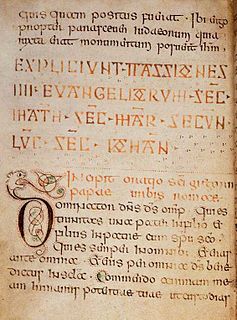
The Book of Nunnaminster is a 9th-century Anglo-Saxon prayerbook. It was written in the kingdom of Mercia, using an "insular" hand, related to Carolingian minuscule. It was probably later owned by Ealhswith, wife of Alfred the Great. It is related to, but of an earlier date than, the Book of Cerne, and also to the Royal Prayerbook and the Harleian prayerbook. Like Cerne it contains the Passion narratives of the four Gospels and a collection of non-liturgical prayers, many of which relate to the Passion. The Book of Nunnaminster shares some poems with the Book of Cerne. It also includes some decorated initials.

Royal Armouries Ms. I.33 is the earliest known surviving European fechtbuch, and one of the oldest surviving martial arts manuals dealing with armed combat worldwide. I.33 is also known as the Walpurgis manuscript, after a figure named Walpurgis shown in the last sequence of the manuscript, and "the Tower manuscript" because it was kept in the Tower of London during 1950-1996; also referred to as British Museum No. 14 E iii, No. 20, D. vi.
Johannes Liechtenauer was a German fencing master who had a great level of influence on the German fencing tradition in the 14th century.

Historical European martial arts (HEMA) are martial arts of European origin, particularly using arts formerly practised, but having since died out or evolved into very different forms.
Martial arts manuals are instructions, with or without illustrations, specifically designed to be learnt from a book. Many books detailing specific techniques of martial arts are often erroneously called manuals but were written as treatises.
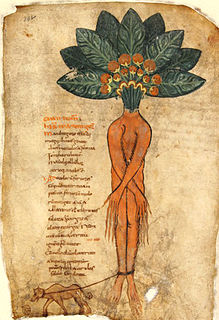
Pseudo-Apuleius is the name given in modern scholarship to the author of a 4th-century herbal known as Pseudo-Apuleius Herbarius or Herbarium Apuleii Platonici. The author of the text apparently wished readers to think that it was by Apuleius of Madaura, the Roman poet and philosopher, but modern scholars do not believe this attribution. Little or nothing else is known of Pseudo-Apuleius apart from this.
The Saint Martial School was a medieval school of music composition centered in the Abbey of Saint Martial, Limoges, France. Most active from the 9th to 12th centuries, some scholars describe its practices, music, and manuscripts as 'Aquitanian'. It is known for the composition of tropes, sequences, and early organum. In this respect, it was an important precursor to the Notre Dame School. Adémar de Chabannes and his nephew Roger de Chabannes were important proponents of this school.
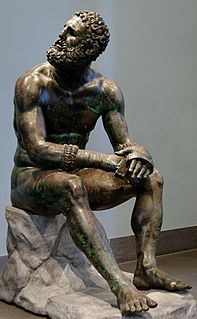
Although the earliest evidence of martial arts goes back millennia, the true roots are difficult to reconstruct. Inherent patterns of human aggression which inspire practice of mock combat and optimization of serious close combat as cultural universals are doubtlessly inherited from the pre-human stage and were made into an "art" from the earliest emergence of that concept. Indeed, many universals of martial art are fixed by the specifics of human physiology and not dependent on a specific tradition or era.
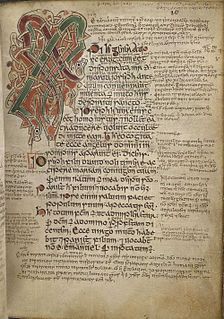
The Gospels of Máel Brigte is an illuminated Gospel Book, with glosses.

Humfrey Wanley was an English librarian, palaeographer and scholar of Old English, employed by manuscript collectors such as Robert and Edward Harley. He was the first keeper of the Harleian Library, now the Harleian Collection.

Minuscule 65, ε 135, formerly known as Ussher 2, is a Greek minuscule manuscript of the New Testament, on parchment leaves. Palaeographically it has been assigned to the 11th century. The manuscript has complex contents including marginalia.

The Harleian Library, Harley Collection, Harleian Collection and other variants is one of the main "closed" collections of the British Library in London, formerly the library of the British Museum.

Minuscule 321, α 254 (Soden), is a Greek minuscule manuscript of the New Testament, on parchment. Palaeographically it has been assigned to the 12th century. Formerly it was designated by 26a and 32p. It has marginalia.

Minuscule 446, ε 507, is a Greek minuscule manuscript of the New Testament, on parchment. Palaeographically it has been assigned to the 15th century. The text represents the Byzantine textual tradition. The manuscript was prepared for liturgical use.
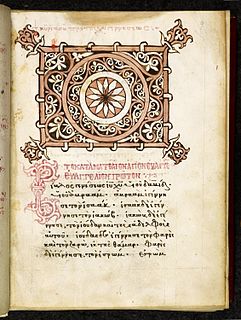
Minuscule 447, ε 507, is a Greek minuscule manuscript of the New Testament, on parchment. Palaeographically it has been assigned to the 15th century.

Lectionary 152, designated by siglum ℓ152 is a Greek manuscript of the New Testament, on parchment leaves. Paleographically it has been assigned to the 9th century.

Minuscule 505, ε 248, is a Greek minuscule manuscript of the New Testament, on parchment. Palaeographically it has been assigned to the 12th-century. Scrivener labelled it by number 567. The manuscript has complex contents. It was adapted for liturgical use.
Harley MS 7334, sometimes known as the Harley Manuscript, is a mediaeval manuscript of Chaucer's Canterbury Tales held in the Harleian Collection of the British Library.

The Harley Lyrics is the usual name for a collection of lyrics in Middle English, Anglo Norman, and Latin found in Harley MS 2253, a manuscript dated ca. 1340 in the British Library's Harleian Collection. The lyrics contain "both religious and secular material, in prose and verse and in a wide variety of genres." The manuscript is written in three recognisable hands: scribe A, scribe B or the Ludlow scribe, and scribe C.
While the majority of surviving sources concerning the use of the two handed Longsword detail the German school of swordsmanship and the Italian school of swordsmanship, there was also a smaller English school with its own techniques. The body of techniques used in English Longsword use has survived to the modern day in three manuscripts: The Ledall Roll, Man yt Wol /The Harley Manuscripts) and the Cotton Titus Manuscript
References
- ↑ J. Hester. The Use of a two-handed sworde ; The Fight Manual of MS Harley 3542 (PDF). The American Academy of English Martial Arts. Retrieved 2015-07-26.
- 1 2 M. Geldof. Strokez off ii hand swerde: a brief instruction in the use of personal arms. Opuscula - Vol 1, No 2 (2011). Retrieved 2015-07-26.
- 1 2 L. Nuvoloni (2008). "The Harleian Medical Manuscripts" (PDF). eBLJ. The British Library (7): 14. Retrieved 2015-07-26.